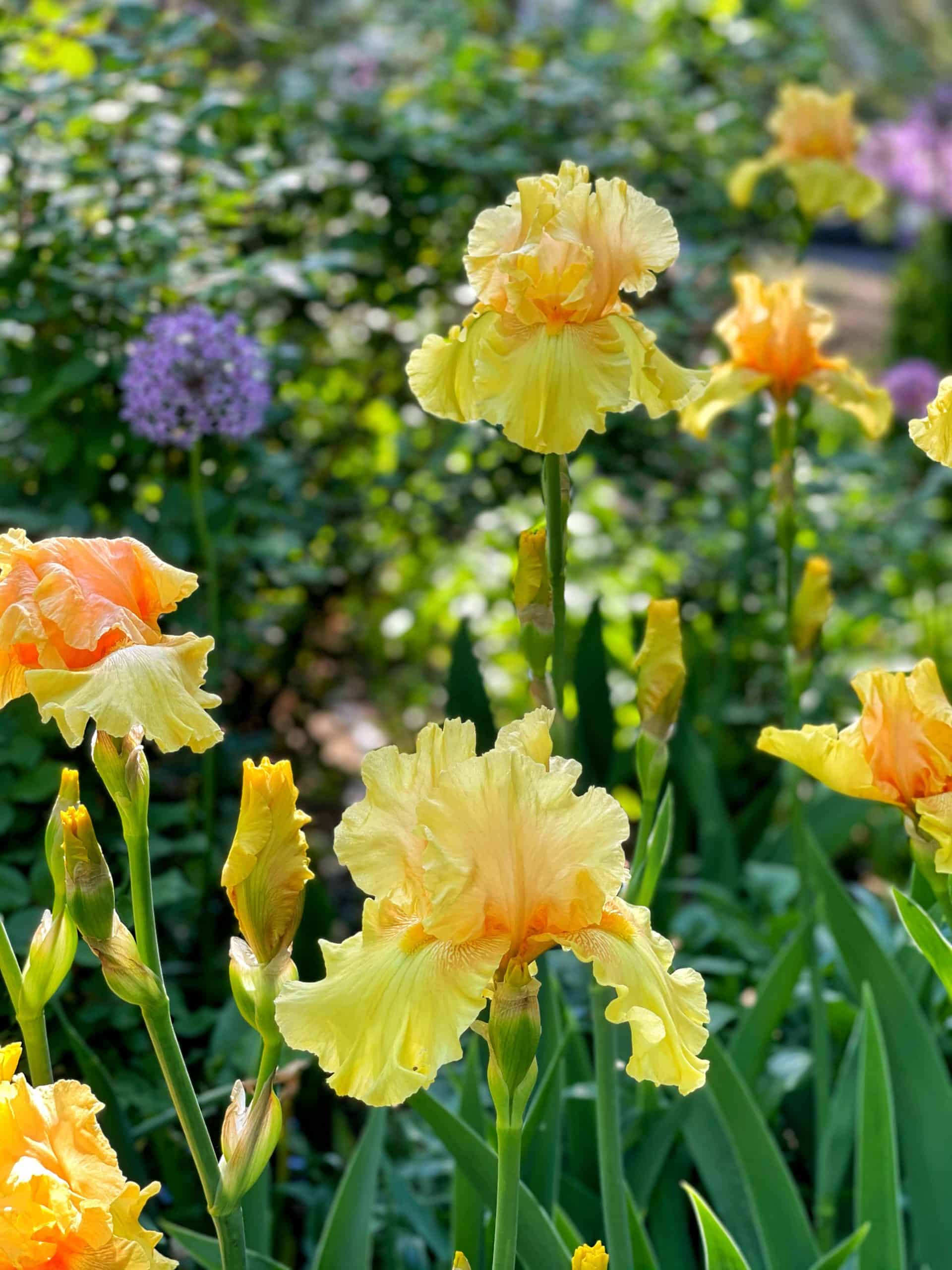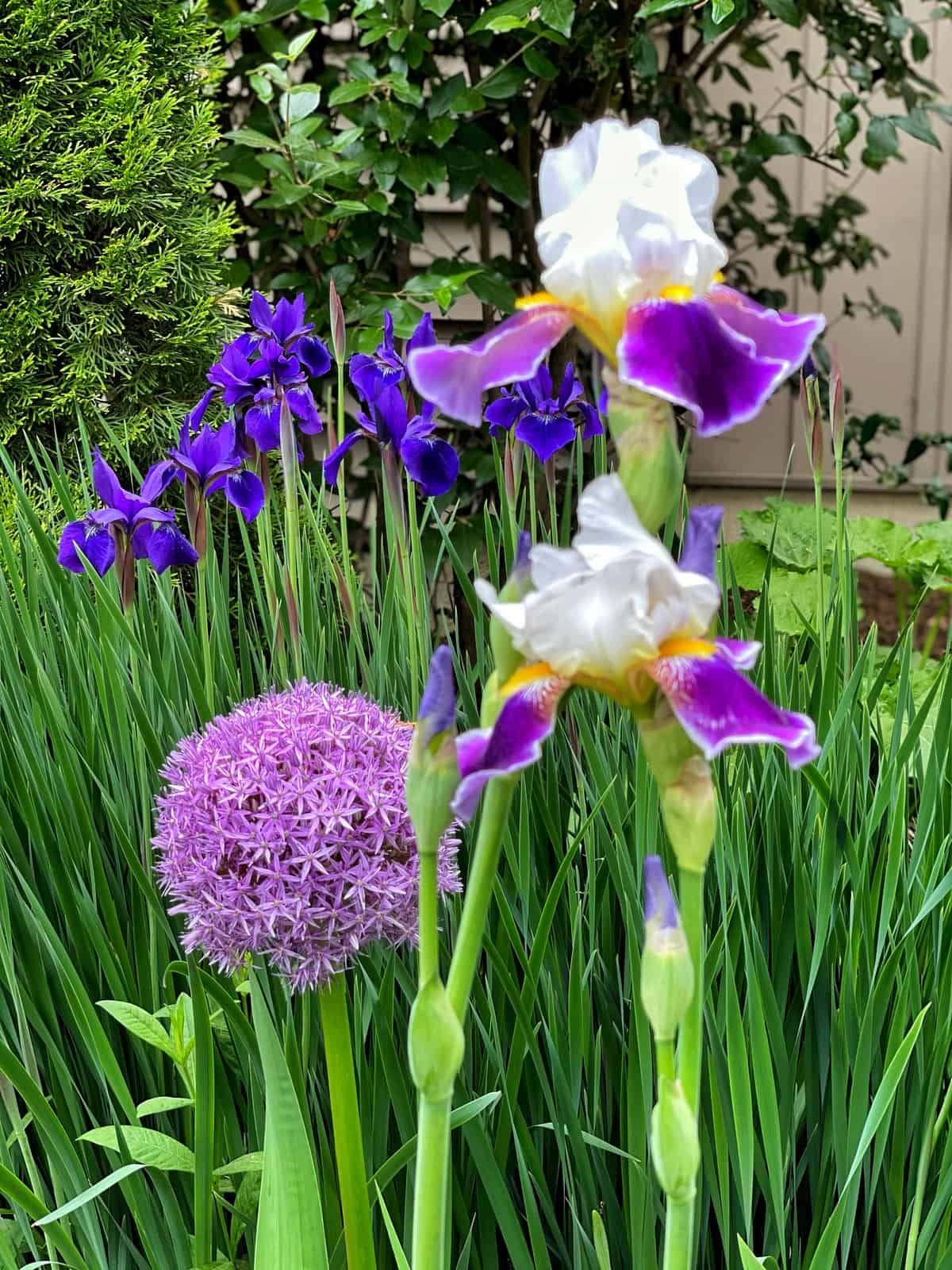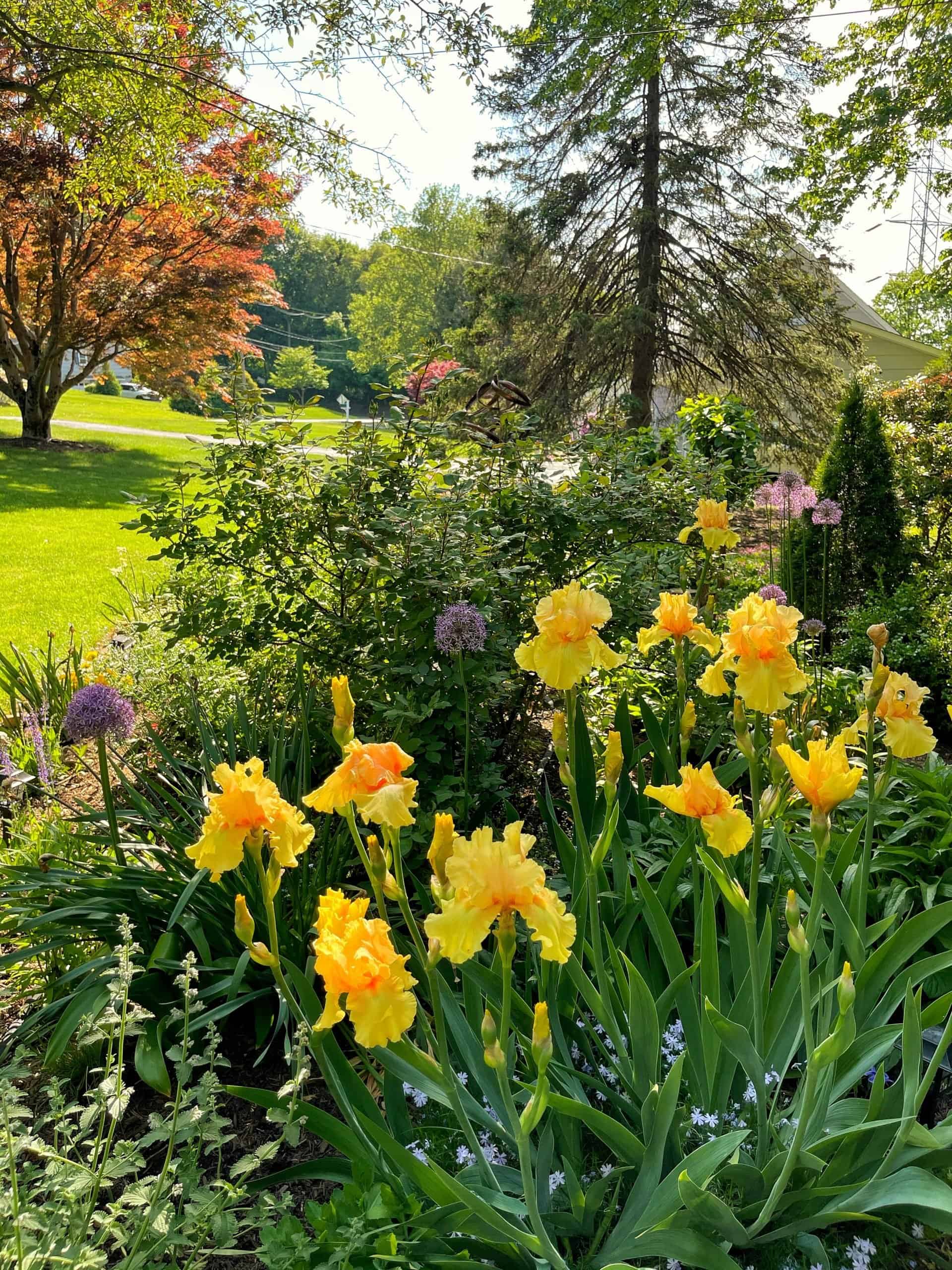Learn everything you need to know about growing and caring for bearded iris, from planting and watering to fertilizing and dividing. Discover expert tips for troubleshooting common problems and ensuring your irises bloom beautifully year after year.
If you are looking to grow an easy-care flower that is deer-resistant and simple to care for, look no further than the bearded iris.
Bearded irises (iris germanica, also known as German iris) are a type of flowering plant that is native to the Mediterranean region and known for their showy flowers that bloom in late spring.
Bearded irises are easy to grow and care for, and they make a beautiful addition to any garden.
This year, I’m working on a beautiful iris bed near the formal garden as they tend to be deer resistant and can take a little bit of shade.
While I brought a few divisions from my former garden, there are a few varieties in my new gardens too. I also just ordered a bunch of new-to-me varieties that I can’t wait to see bloom!
Here’s what you need to know to grow beautiful bearded iris flowers.
(Posts on stacyling.com may contain affiliate links. Click HERE for full disclosure.)

Truly, you can’t beat bearded iris blooms. They are stately flowers with lots of incredible detail that sit upon a tall flower stalk. While the different varieties have lots of showy colors, one of my favorite features of the bearded iris is the ombre colors in the petals.
In addition to their colorful flowers, bearded irises also have attractive, sword-like foliage that is green or blue-green in color. The iris flower colors are vast and beautiful so shop around for the colors that speak to you for your garden.
My mother-in-law gave me a clump of rhizomes when we first moved to our family home over 23 years ago and a division of those very same flowers moved with me to my current home.
They are so easy to care for, the deer leave them alone, and are a welcome site in late spring through early summer.
While the flowers don’t last more than a few weeks, if you plant different varieties you can get an extended bloom time that is just breathtaking. To me, bearded irises look best when planted en masse in mixed borders and cottage gardens, but they also look amazing in rock gardens and near pond gardens as well.

Understanding Bearded Irises
Bearded irises are popular perennials known for their striking, colorful flowers and hardy nature. Suitable for hardiness zones 3-9, bearded irises thrive in full sun and well-drained, loamy soil. These plants typically grow to a height of 1-3 feet and spread 1-2 feet wide, making them excellent for borders, beds, and as standalone specimens.
Bearded irises bloom in a variety of colors, including blue, purple, white, yellow, and more, typically from spring to early summer.
These irises are generally low-maintenance and resistant to deer, making them a reliable and attractive addition to any garden. With proper care, bearded irises can provide years of stunning blooms and elegant foliage
- Genus: Iris
- Common Name: Bearded Iris
- Plant Type: Perennial
- Hardiness Zone: 3-9
- Light: Full sun
- Soil Requirements: Well-drained, loamy
- Height: 1-3 feet
- Width: 1-2 feet
- Flower Color: Various colors (blue, purple, white, yellow, etc.)
- Foliage Color: Green
- Bloom Time: Spring to early summer

The Benefits of Growing Bearded Irises in Your Flower Garden
If you aren’t convinced yet that you should grow bearded irises in your garden this year, you will be after you read this list!
Bearded Iris: Easy-to-Grow Late Spring Flowers
Bearded irises are super easy to grow and care for, making them a good choice for gardeners of all skill levels. They are hardy plants that can tolerate a wide range of temperatures and soil conditions, and they are generally pest-free.
Bearded irises are dependable, long-living perennials that can last for several years. In fact, I’ve still got plants that my mother-in-law gave me over 25 years ago! And I’ve had a love affair with them ever since.

Bearded Irises Are Stunning Flowers
Bearded Iris are known for their graceful, showy flowers that come in a variety of brilliant colors and patterns. From deep purples and blues to sunny yellows and whites, there is a bearded iris to suit every garden. Bearded iris blooms have large, showy flowers that are typically 2-6 inches in diameter.
Bearded irises come in a wide range of colors and patterns, including solid colors such as purple, blue, yellow, pink, and white, as well as bicolors and patterns such as dots, splashes, and veining. Some varieties have fragrant flowers, while others do not.
The flowers of bearded irises typically bloom in the late spring and early summer. However, by planting a reblooming iris or different bearded iris varieties, you can extend the bloom time.
While they are mostly grown for the flowers, the sword-shaped foliage is a welcome change in gardens as it contrasts mounded forms of other plants.
Bearded Irises Are Low-Maintenance
Once established, bearded irises require minimal care from the gardener during the growing season. Mulch yearly and water regularly if no rain, and divide every 3-4 years to encourage healthy growth and an abundance of blooms. The plants last a really long time and require minimal effort from the gardener throughout the growing season.

Bearded Irises Are Deer Resistant Plants
Bearded irises are not favored by deer, making them a good choice for gardens in areas with a high deer population.
In my gardens, we get herds of deer. Both here at the new house AND our former home. I’ve been growing them for the longest time, never protecting them, leaving them be, and have never had a problem with deer.
The former homeowners have them planted throughout the gardens and I haven’t seen a nibble on them here either. So that’s a really good indicator that unless they are starving, they’ll dine on other things.

Bearded Iris Is Easy to Propagate
Bearded irises should be divided every three to four years to encourage healthy growth and prevent overcrowding. As irises mature, the rhizome produces more rhizomes. You’ll know it’s time to divide when the plant produces fewer flowers.
The best time to divide bearded irises is after flowering when they go dormant during late summer. This will reduce the opportunity for bacterial rot to form.
Dividing your irises also allows you to propagate new plants from your existing ones, and it can help to rejuvenate older plants that are not blooming as well as they used to.

How to Plant Bearded Iris Bulbs: A Beginner’s Guide
Plant bearded irises in a sunny location to ensure they receive at least 6 hours of sunlight daily, which is crucial for abundant blooming. While they love direct sunlight with a full day of sun, they can also grow and bloom well in partial shade locations.
When caring for irises, plant them in a sunny site with well-drained soil that is rich in organic matter. They prefer soil that is neutral to slightly alkaline soils, with a pH between 6.5 and 7.5. The soil should be well-drained to prevent rhizome rot; raised beds or slopes are ideal planting sites if your garden soil tends to retain water.
Bearded irises grow from underground stems called rhizomes, which produce new leaves and flowers each year. Bearded iris rhizomes should be planted about 4 inches deep with a slight mound to accommodate root growth and 12-18 inches apart to allow for proper growth and flowering. And make sure the fanning of foliage is facing in the same directions when you plant.
Keep the tops of the rhizomes exposed. When mulching, make sure there is no mulch sitting on top or they may not bloom.
I’ve seen many landscapers completely bury them with mulch and that’s a surefire way to get no blooms. If they are deep enough beneath the mulch, it can kill them altogether.
For best results, plant bearded iris rhizomes in spring or fall so they establish themselves before cold winter temperatures arrive.

Bearded Iris Care: Nurturing Your Flowers
Caring for bearded irises involves understanding their specific needs to ensure they thrive and produce beautiful blooms year after year. Here’s what you need to know!
Watering Bearded Irises
Water your bearded irises regularly, making sure to keep the soil evenly moist but not waterlogged as you don’t want them to get a fungal disease. It is important to water it regularly during the first year of growth to help establish its roots. In the following years, it may only need watering during periods of prolonged drought.
Golden rule to follow: aim for watering the roots at the base of plants, not the foliage. This is why drip irrigation and soaker hoses work incredibly well in flower gardens. Overhead watering can encourage pest problems and fungal diseases. Instead, use watering cans, soaker hoses, or drip irrigation systems to deliver water directly to the root zone where the plant needs it most.
One of the reasons you want to avoid watering from above is because when the foliage stays wet and the sun goes down, that water does not evaporate as well which causes fungal diseases. The same goes for the soil. When plants sit in wet soggy soil overnight it encourages pest and disease problems. And we don’t want that with our beautiful bearded iris blooms!
In addition to watering the base of plants, it’s also really important to water in the earlier part of the day instead of later in the day. It is better for your flower garden and plants because they will have a chance to dry out before nightfall when the temperatures cool.

Fertilizing Bearded Irises
I generally don’t fertilize my irises and focus more on good soil quality with lots of compost, leaf mold, and other organic matter. I’m a huge proponent of focusing on soil quality instead of feeding perennials, shrubs, or trees with fertilizers. If you’ve already taken a soil test, follow any recommendations those results provided. Add compost, aged manure, leaf mold and other organic matter yearly to help improve your soil, improve drainage, and supress weeds.
The only situation I recommend fertizling bearded irisses is when they are grown in pots. In that circumstance, I would use a balanced slow-release fertilizer in the spring in addition to adding compost and other organic matter.
Mulching Around Your Bearded Irises
It’s always a great idea to mulch around your bearded iris. I recommend using organic mulch like wood chips because it will break down and help improve your soil over time while suppressing weeds, maintaining soil temperature, and helping plants retain moisture.
When you mulch, make sure you keep it away from the base of plants and do not cover the rhizomes. Mulching right on top of the base of plants encourages pest and disease problems – which we don’t want, am I right?
After our landscapers mulch the beds, you’ll frequently find me outside uncovering all my rhizomes because they are usually buried under the fresh mulch.

Weeding Around Bearded Iris
It is important to pull weeds around bearded iris bulbs and remove fallen leaves from the surface so it continues to get much-needed sunlight throughout the growing season.
Pruning Bearded Irises
Prune old blooms and stalks promptly after flowering so the iris devotes energy to growth. If you have a reblooming iris, removing the old flowers and stalks encourages another set of blooms.
Staking Bearded Irises
Sometimes tall bearded iris blooms are so heavy, they may need extra support. I generally love to use these grow-through plant supports because they have a grid and support the flowers really well.
But if you get to staking them when it’s too late, I grab these half-moon garden stakes and they work equally as well. Where bearded irises are concerned, I typically just use the half-moon supports because more often than not, the plant keeps itself upright.
If there’s inclement weather or high winds they may start to lean a little too much for my taste, so I just grab the half-moon supports and you don’t even notice they’re there.

Common Pest and Disease Problems
Bearded irises are generally pest-free, but they can be prone to fungal diseases such as bacterial leaf spot and the iris borer.
For best results, avoid overwatering and make sure the iris bulbs are sited in a sunny location with good air circulation.
Similar to spring flowering bulbs, the foliage stores energy for next year’s growth. Keep the foliage until fall but you can cut the brown tips and flowering stalk to the ground before to prevent rot and overwintering pests.
After the flowers fade, remove the seedpods as they take away nutrients needed from the rest of the plant.
With proper care, bearded irises are beautiful and low-maintenance additions to your garden.

How to Divide Bearded Irises: Step-By-Step Instructions
Iris bulbs should be divided every three to four years to encourage healthy growth and prevent overcrowding (see below to learn how).
To reduce plant stress and encourage strong root growth, cut the foliage back to roughly a third of its height before dividing.
Carefully dig up the clumps of rhizomes using a shovel or spade. Be gentle to avoid damaging the clumps of iris rhizomes or roots by lifting them out with a garden fork. And keep try not to pierce the rhizomes while working.
Then cut the rhizomes into smaller sections, making sure each section has at least one fan of leaves and a few roots. You should be able to do it with your hands. If a knife is needed, make sure it is clean and disinfected first with a 1:10 bleach-to-water solution.
Discard any damaged or diseased rhizomes because you don’t want to plant those. Keep rhizomes that have healthy roots and one or two leaf fans.
Next, replant the divided rhizomes. When planting, dig a shallow hole that’s roughly 10″ diameter by 4″ deep. Add soil to the center of the hold so you can set the rhizome on top and spread the roots out.
Then backfill with good garden soil but make sure the rhizome top is visible to the surface of the soil. When you plant them too deeply, they may not flower.
By following these steps, you can easily divide your tall bearded irises and propagate new plants from your existing ones.

Troubleshooting a Lack of Bearded Iris Flowers
There are a few reasons bearded irises may not bloom. So here are a few things to consider when troubleshooting why yours are not flowering.
- They need full sun (6-8 hours) and well-draining soil to thrive. If you lack blooms, take a serious look at where they are planted and note how much sun that area receives.
- Make sure the bearded iris rhizomes are not planted too deeply or covered with mulch.
- If they are newly planted, they may need some time to establish themselves – so be patient. This has happened to me before with my bearded irises, peonies, and hydrangeas. Sometimes, patience is all that’s required.
- It’s always a good idea to check your soil to make sure it has a strong basis for your plants. Get a soil test to determine if the soil is lacking nutrients and amend the soil accordingly.

Growing Bearded Iris in Pots
Growing bearded irises in pots is an excellent way to enjoy their stunning blooms even if you have limited garden space. Choose a pot at least 12 inches in diameter with good drainage to prevent root rot.
Fill it with well-drained, loamy soil and place the pot in a sunny location where the irises can receive at least 6-8 hours of sunlight daily. Water the plants thoroughly after planting, then allow the soil to dry out between waterings to avoid overwatering. Regularly deadhead spent blooms and divide the rhizomes every few years to ensure healthy growth and abundant flowering.
Since pots tend to dry out quicker in the summer, I also recommend running drip irrigation set on timers so it’s easier to maintain.
In colder climates, potted bearded irises will need protection from freezing temperatures. To successfully overwinter them, choose varieties that are two zones hardier than your growing zone This means, if you garden in zone 6 you’ll want a variety that can handle zone 4.
You can also try moving them to a sheltered location like a garage or unheated shed and insulating the pot with burlap or bubble wrap.

Top Bearded Iris Plant Varieties
There are soooooo many types of bearded irises to love. I planted a bunch of new to me varieties last year that I cannot wait to see bloom this spring! My goal is to have a garden filled with the bearded iris flower.
Here’s a sample of my favorites that I’m growing here in my zone 6b garden in New Jersey!
- Angel’s Rest
- Mother Earth
- Dream of You
- War Chief
- Whale’s Tale
- All Night Long
- Champagne Elegance
- Silken Trim
- Cafe Bleu
- Petalpalooza
- Skirting the Issue

Companion Planting for Bearded Iris
If you are adding bearded iris flower to your garden this year, there are lots of great flowering annuals, spring flowering bulbs, and perennials that look amazing with the German iris. Here are some plants that I think look pretty with it.
- Peonies
- Nepeta
- Lavender
- Pansies
- False Indigo
- Alliums
- Sedum Autumn Joy
- Daffodils
- Tulips
- Roses
- Smoketree
- Columbine
For more information about growing and caring for bearded irises, check out the following extension articles:

Bearded Iris Care FAQ: Answers to the Most Common Questions
When is the best time to plant bearded iris?
The best time to plant bearded iris rhizomes is from late summer to early fall, typically August to September. This timing allows the plants to establish roots before winter. For those in colder climates, planting in early spring is also an option, giving the plants ample time to grow before the blooming season.
What type of soil is best for bearded irises?
Bearded irises prefer well-drained, loamy soil. Good drainage is essential to prevent root rot, which can occur if the soil is too waterlogged. Planting them on a slope or in raised beds can help improve drainage, especially in areas with heavy rains or snowfall.
Do bearded iris spread?
Yes, bearded irises do spread. They grow from rhizomes, which are horizontal underground stems. Over time, these rhizomes multiply, producing new shoots and creating a larger clump of irises. Typically, bearded irises will spread and form dense clusters over a few years. They do not spread in an invasive or aggressive manner.
To manage their growth and ensure healthy blooming, it’s important to divide the rhizomes every 3-5 years. This division not only controls their spread but also rejuvenates the plants, leading to more vigorous flowering.

Final Thoughts About Growing and Caring for Bearded Iris
Bearded irises are a stunning addition to any flower garden, renowned for their vibrant, ruffled blooms in a wide array of colors. Their beauty and resilience make them an easy-to-grow favorite for gardeners of all levels.
With minimal care, including full sun exposure, well-drained soil, and occasional division of rhizomes, these perennials reward you with an abundance of elegant flowers each spring. I absolutely love having bearded irises in my garden; their striking appearance and low maintenance needs make them a joy to grow.
If you’re looking to add a touch of elegance and color to your garden, consider planting bearded irises. You’ll fall in love with their effortless charm and beauty. Start growing your own bearded irises today and experience the joy they bring to your garden!
Do you grow bearded iris? What varieties are you growing if you do? If you have any comments, questions or suggestions, please let me know in the comments below. And if you think someone else would love this post, feel free to share it with them or pin it to your favorite Pinterest Board.
To drill down on more beginner gardening techniques and tips, please read these post:
For more information about bearded iris care, please see this article from the University of Illinois Extension Service.
Thank you so much for following along.
Enjoy a beautiful day! xo













